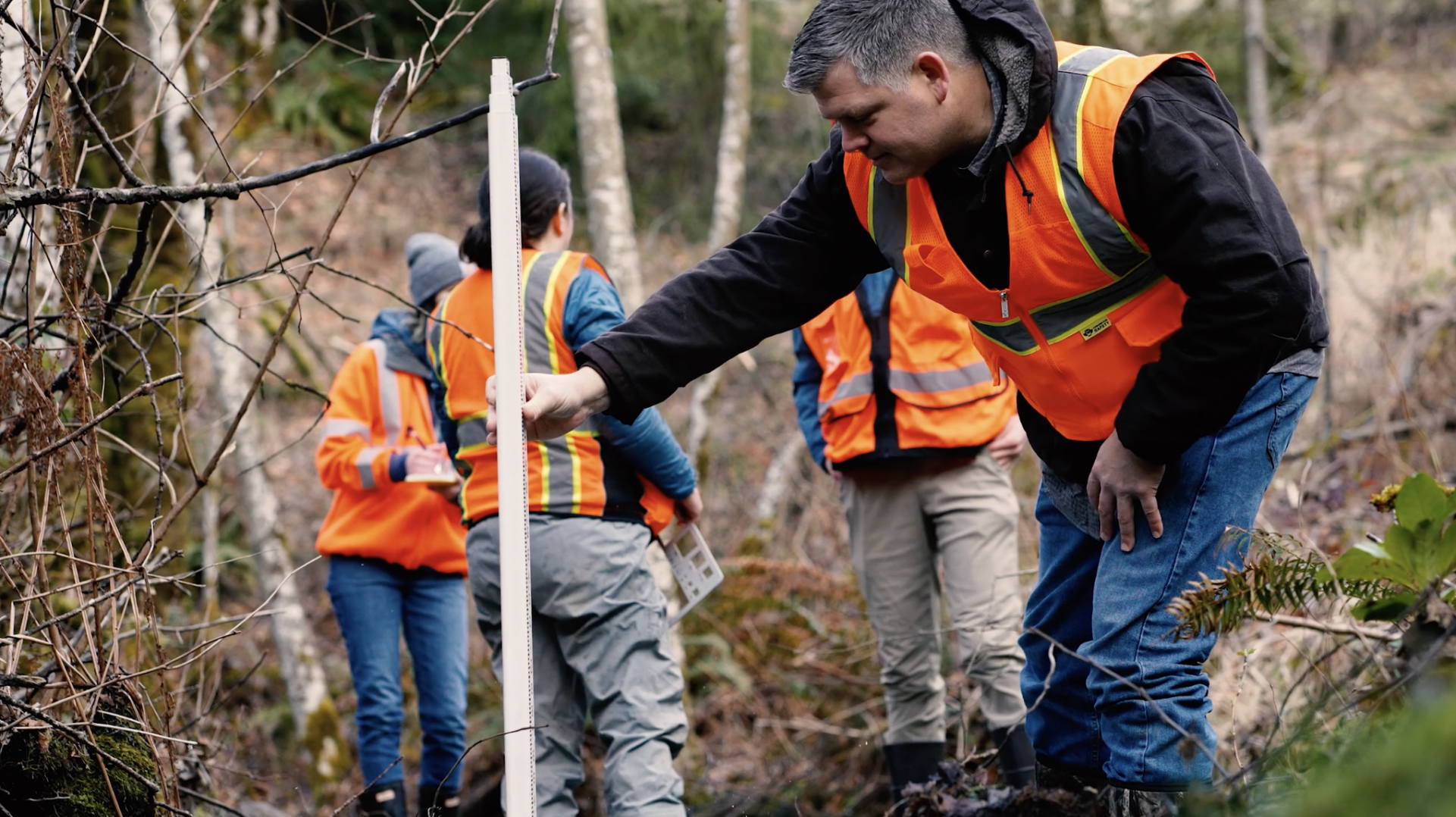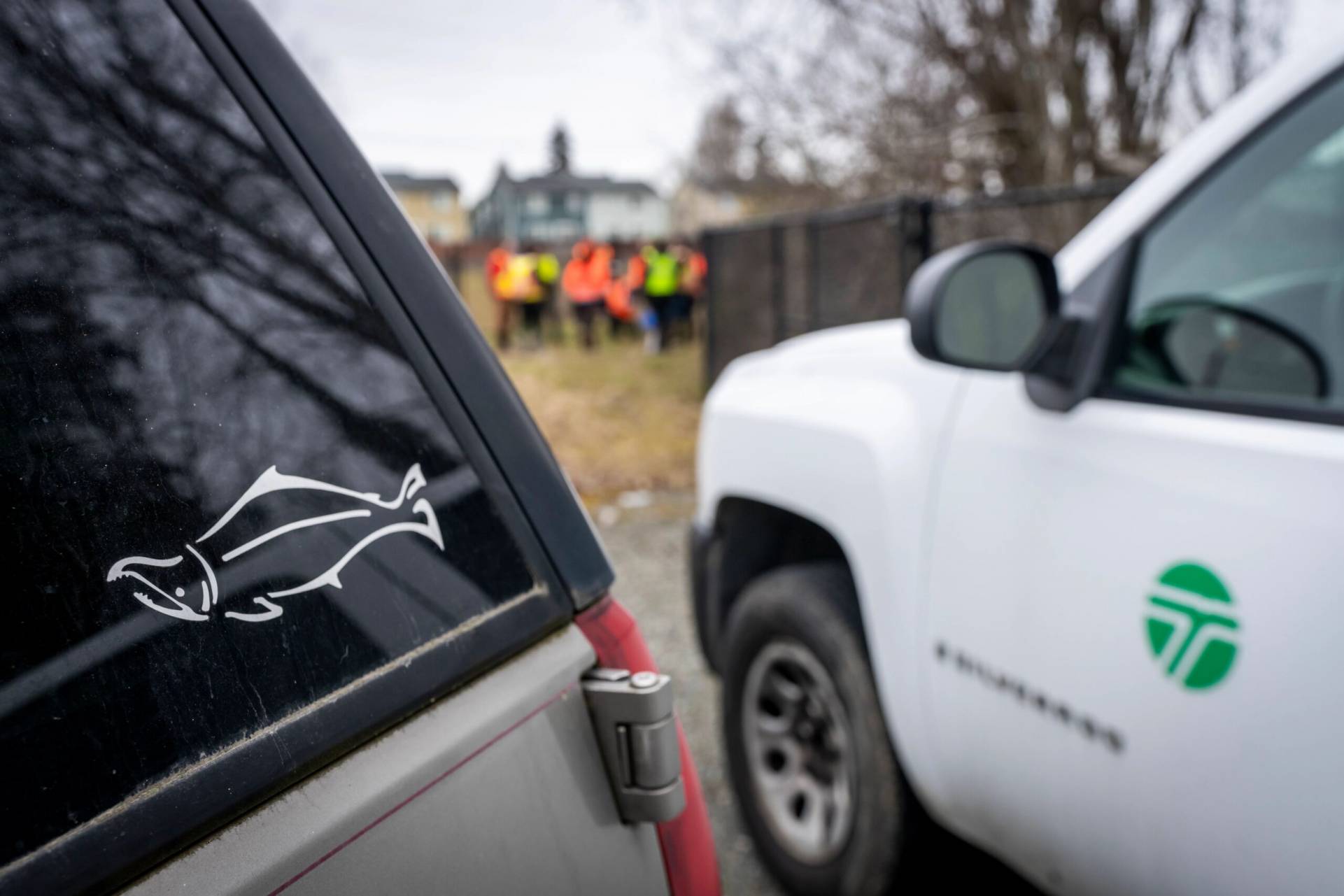Restoring Passage
Washington State Department of Transportation’s Fish Passage Program removes migration barriers to protect important fish species and foster healthy waterways
DESIGNER
2023
The Washington State Department of Transportation has been working for many years to remove fish passage barriers. Since 2013, WSDOT has concentrated most of its fish passage work in Western Washington because of a federal culvert injunction. Twenty-one northwest Washington tribes asked the U.S. District Court to find that the State of Washington has a treaty-based duty to preserve fish runs. They wanted the state to repair or replace culverts that impede salmon migration.
The right of taking fish is secured to tribes in the Stevens Treaties. Therefore, the court ruled in the tribes’ favor, requiring the state to refrain from building or operating culverts under state-maintained roads that hinder fish passage. Issued in March 2013, the permanent injunction requires the state to significantly increase the effort for removing state-owned culverts that block habitat for salmon and steelhead by 2030.
Opening habitat allows more salmon and steelhead at all life stages to access important spawning and rearing habitat, including areas that have been inaccessible for years. Installing structures like bridges and culverts that allow for natural stream processes help protect and restore salmon runs, ultimately benefiting both the Pacific Northwest landscape and economy.
As Julie Hampden, HNTB environmental lead on the Fish Passage Program, said, “The Fish Passage Program’s efforts will help to ensure the habitats in these streams support a thriving fish population.”
Under a general engineering consultant (GEC) contract, WSDOT selected HNTB to support fish passage delivery in its Northwest Region. HNTB is the prime consultant under the GEC, working with a diverse array of subconsultants to meet WSDOT’s needs. GEC team members provide a variety of roles — geomorphologists; stream design and environmental engineers; fishery biologists; project and procurement managers; project control staff; roadway, drainage, geotechnic and structural engineers; utility engineers and landscape architects — who rise each morning to meet the challenges of this work. Foundational elements, including stream hydraulics, geomorphology, design and project advertising, are underway.
Multidisciplinary Team
Planners
Environmental planners
Stream design engineers
Environmental engineers
Water resources engineers
Fishery biologists
Habitat biologists
Fluvial geomorphologists
Project and procurement managers
Project control staff
Roadway engineers
Drainage engineers
Geotechnic engineers
Structural engineers
Utility engineers
Hydrologists
Landscape architects
Traffic engineers
Real estate
Communications
GIS specialists
CADD technicians
Complex projects and smart solutions
The multibillion-dollar Fish Passage Program is comprised of hundreds of individual projects, each with its own technical challenges and opportunities. Under the GEC contract, HNTB’s “cradle-to-grave” role includes everything from early planning and environmental services through procurement support and final engineering design, said Don Sims, HNTB project director.
“Fish Passage is a non-traditional HNTB project that draws on both environmental expertise and civil engineering to solve the problem,” he said. “The work taking place now considers the impacts of current infrastructure and determines how we can make lasting improvements. During the life cycle of the program, HNTB in collaboration with WSDOT will help to build new bridges and replace culverts on roadways — the kind of work HNTB has a long history of delivering.”
WSDOT prioritizes individual Fish Passage projects that open the most habitat fastest, often partnering with cities and other entities to correct multiple barriers at the same time and bundling correction efforts to minimize traffic impacts. Many projects are underway at once and more information can be accessed via the agency’s website.
The diverse skillsets provided to WSDOT through the GEC assists the agency in delivering this incredibly complex program. Three projects — each posing its own distinct challenges — illustrate the types of technical challenges faced by WSDOT:
- Project currently under design that will remove a barrier at Lake Creek along I-90, where the stream came from a steep hillside onto an abruptly flattened slope. There, water and sediment spread out and I-90 further impeded fish passage. The GEC team, as engineering design lead and technical expert, has been working as a blended team with WSDOT staff to develop preliminary designs for this site that provide fish passage and effectively manage sediment loads. The GEC team is designing and modeling a series of step pools to restore the stream channel and function at this location.
- Sites along Friday Creek near I-5 include 10 separate barriers. Each will be fixed in context with the others, so that correcting one doesn’t inadvertently create new problems at the other locations. The GEC provided a wide array of support to design and help deliver the project(s) at this location, including preliminary hydraulic design, stream design, hydraulic modelling, sediment transport modelling, environmental coordination and documentation, permitting and procurement development.
- At the Eagle Creek site on SR 20, where a new culvert will be placed, the GEC stream design team and roadway engineers worked collaboratively with WSDOT project engineers to plan for enough space between the top of that structure and the roadway above in order to avoid creating a pinch point where debris could collect during heavy rains and cause the road to flood. In addition, the new structure must allow sufficient space for periodic road and culvert maintenance activities. At this location, the roadway will be raised to effectively address fish passage goals, safety and site constraints.
Unique but perfectly aligned
HNTB’s team represents multiple offices and disciplines — an army of engineers, scientists and subconsultants that underpin the partnership between the firm and WSDOT, said Henry Hu, HNTB water resources lead.
“I’ve been in the industry for awhile, and it’s amazing how much I learn constantly from all the co-managers, partners and our own experts. You have to be willing to look, listen and make change when warranted. Our efforts have become magnets for other partners upstream and downstream, that create even more enhanced habitat,” said Chris Damitio, assistant regional administrator, Northwest Region, WSDOT. “It’s important to be an ally and trusted partner in these critical improvements. These efforts not only enhance communities but reduce maintenance and increase sustainability of our transportation system.”
Fish Passage also is unique in the level of collaboration between WSDOT, the project team and key project partners, including Native American tribes and the Washington Department of Fish and Wildlife. All are at the table participating in the design process. The team is further coordinating design with the Federal Emergency Management Agency and local communities to ensure that project work avoids negative effects on how water functions in floodplains.
“The industry has advanced in our understanding of the natural world and ecosystems since the mid-1900s, when the infrastructure we’re addressing was built,” Hampden said. “Fish Passage, with its capacity questions and ecological and environmental intricacies, is the ultimate test of an engineering firm like HNTB, challenging our designers not only to manage the complexities of building a transportation corridor but also to build it in this interconnected and complex natural system.”
A legacy of promise
As a trusted WSDOT partner, HNTB already had a long history of project delivery on large programs for the agency. Considering the diverse nature of the Fish Passage Program, WSDOT and HNTB blended their expertise, filling gaps on the technical skills roster with carefully selected subconsultants.
Many of those subcontractors are small, Historically Underutilized Businesses HNTB is mentoring so they can learn about and align with WSDOT expectations. That collaboration has built a strong regional bench with the capacity to effectively deliver the program.
While maintaining quality across such a large multidisciplinary team could be difficult, HNTB has worked closely with WSDOT and the project team to create processes that meet the particular needs of the project designs. For example, rather than having a single technical reviewer for a report, a peer review team — which includes a representative from each relevant discipline — reviews the information.
“While there are certainly unique aspects to our Fish Passage Program, this is not the only substantially sized state effort at habitat restoration, improved infrastructure resilience, Tribal partnering, regulatory efficiencies or multisite capital program requiring innovative teamwork, collaboration, design and contracting methods. Our program offers a multitude of strategies and lessons in these aspects that have improved our ability to deliver this program. Of course, the most important aspect of any challenge like this is having a great team to work with and a common vision. Our consultant teams, agencies, tribes, communities and contractors,” said Cameron Kukes, assistant regional administrator, Northwest Region, WSDOT. “We have a fantastic team in delivering this program and we’ve learned a lot on our path to getting that.”
Hu said the WSDOT partnership and the team relationship are realizing and accelerating significant advancements in stream design and environmental practices. A single removed barrier can deliver impressive benefits by improving fish access for miles, both upstream and downstream. When rivers and streams reconnect, fish can better reach the habitat they need to access food resources, reproduce, escape predators and find refuge from high winter stream flows.
“This important component of protecting and restoring fish populations will have a meaningful impact to stakeholders, to the communities that are reliant upon those fish and fisheries resources and to stream-based ecosystems throughout Western Washington,” Hampden said. “The Fish Passage Program is a path of opportunity that leaves a legacy of societal and environmental benefits.”



“This important component of protecting and restoring fish populations will have a meaningful impact to stakeholders, to the communities that are reliant upon those fish and fisheries resources and to stream-based ecosystems throughout western Washington. The Fish Passage program is a path of opportunity that leaves a legacy of societal and environmental benefits.”
“Fish Passage is a non-traditional HNTB project that draws on both environmental expertise and civil engineering to solve the problem.”
“Our primary goal is successfully restoring access to habitat for salmon in the most sustainable, practical, and efficient way. We are also very focused on integrating our work in this program with the tribes, communities, municipalities and other entities with interests in these areas to maximize the benefits while minimizing impacts to traffic, property and businesses.”
SEE MORE ARTICLES
MORE DESIGNER STORIES
KC Levees Program
Dallas Love Field
CID Green Infrastructure Project
I-4 Ultimate
Orange Line BRT

